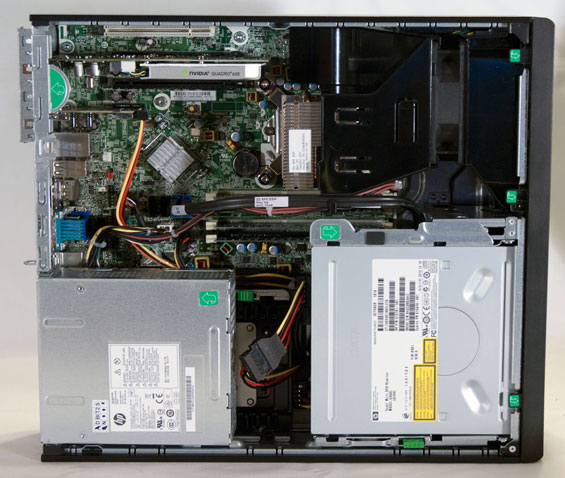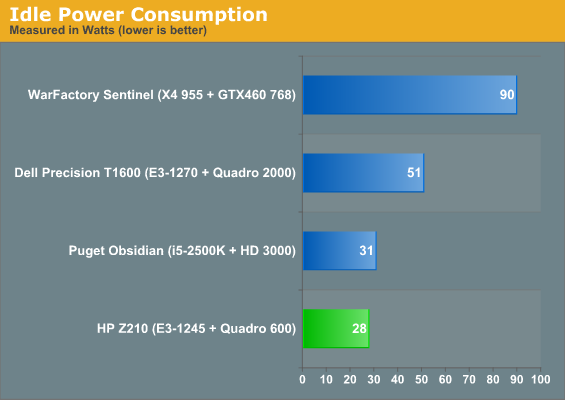HP Z210 SFF Workstation: Serious Power in Cramped Quarters
by Dustin Sklavos on August 29, 2011 8:10 PM EST- Posted in
- Systems
- IT Computing
- Intel
- HP
- Xeon
- Quadro
- Workstation
- SFF
- Enterprise
- NVIDIA
Build, Noise, Heat, and Power Consumption
The build and build quality of the HP Z210 SFF are probably the most striking aspects of it right off the bat. I personally love smaller computers, but there's a real benefit to going with a workstation from HP or Dell as well: they're vastly easier to service than a garden variety desktop build. Despite the small case, HP has designed the Z210's chassis to be incredibly easy to work inside.

While initially appearing very compact and difficult, there are a couple of extremely smart decisions on HP's part. First, the cooling design minimizes the amount of work the intake fan has to do and as a result, the Z210 gets by with just one 80mm fan. The only thing between the processor and cool air from the front of the case is the fan and heatsink assembly, and this allows the chip to run very cool and keeps the fan at a low speed, making it virtually silent. Second, the power supply easily tilts up to allow access to the single 3.5" internal drive bay, and the optical drive tilts up allowing easy upgrading and servicing of whatever parts the end user has elected to use for the 5.25" and 3.5" external bays. Third, the Z210 is just plain easy to get into; you can lock the side panel to the case with a conventional padlock, but otherwise the panel simply lifts off with the use of a lever. The Dell Precision T1600 was just about as easy to use, and frankly I wouldn't mind seeing more of these design cues materialize in consumer enclosures.
When you look inside the Z210, though, you can pretty easily see where sacrifices had to be made to reach this form factor, and the one that hurts the most is the single internal 3.5" bay. You can increase the number of storage drives inside the system through a variety of means (probably the easiest is to mount one in the external 3.5" bay), but our review unit had a 160GB SSD...and that's it.
Finally, when talking about the build we would be remiss in not at least mentioning some of the secret sauce HP includes with their workstations, specifically the HP Performance Advisor. The Performance Advisor is software they're very proud of and I can see why: it can give you exceptionally detailed information about the particular system configuration, but its major claim to fame is the ability to change BIOS settings and suggest new drivers depending on the software you want to run. Unfortunately the only software we were able to test this with was Adobe Premiere Pro CS5.5, and it struck out there as I mentioned before. Conceptually it's fantastic, but it looks like it may need a little more work and optimization.
It won't surprise you to know that power consumption in the Z210 SFF was fantastic, and it's here where HP delivers a major advantage over Dell. While Dell will charge you for the privilege of a more efficient power supply, HP promises 90% efficiency and 80 Plus Bronze certification across all of the power supplies in their enterprise desktops.


That efficient power supply winds up paying dividends. The Puget Systems Obsidian is no slouch (and is indeed a desktop designed specifically for small business), including an Antec TruePower 650 80 Plus Bronze-certified power supply, and idle power consumption is roughly in the margin of error. At idle, though, the Z210 sports a brutal 20-watt lead on the Dell T1600, which makes do with a low-efficiency power supply coupled with a pair of mechanical hard drives in RAID 0. The Z210 and T1600 have processors that perform fairly comparably, while the workstation cards have roughly a 20-watt TDP gap separating them, yet between the storage, cards, and power supplies, the Z210 stakes out a 60-watt lead under load.
With low power consumption comes low heat generation. Unfortunately HWMonitor didn't run properly on the Z210; AIDA64, on the other hand, was able to read temperatures fairly well. Cores idled in the high 40s, but load temperatures were good, never breaking 70C under stress. For the most part the Z210 retains a cool head, and even under load barely generates any noise. You can hear a very soft hum at best, but the efficient cooling design keeps the whole system running quietly. Most of the desktop cases I test could stand to run this softly.














25 Comments
View All Comments
Dustin Sklavos - Wednesday, August 31, 2011 - link
It's my understanding some of that is covered by SPECviewperf.WillR - Tuesday, August 30, 2011 - link
I know this will seem out of left field and irrelevant to most. But it's nice to see a SFF system with a CF card slot. SD and its micro sibling have almost become a de facto standard with all other card types ignored, and that leaves Canon DSLR owners with limited options. Usually the solution ends up being an external card reader, and that's frankly annoying these days.Not that I use it also, but no Firewire? Kinda surprising.
Oscarcharliezulu - Wednesday, August 31, 2011 - link
Lots of talk and charts on gaming performance for a non gaming machine - seems like review filler to me sorry. I wouldn't mind a bit more analysis on benefits of the workstation class against consumer, and bench some real workstation apps. Love the SFF but they need to address the storage issue, perhaps I could use a NAS but then would spend a lot of time copying projects in and out. Comment to HP - it's horrifically ugly - what happened to good design? I'd be embarrassed to let clients see it.hampuras - Wednesday, September 7, 2011 - link
How is this good or not for Photoshopping? Or would be better with an iMac?Zumzifero - Tuesday, October 25, 2011 - link
I'm looking for a nice small workstation which I'd mostly use on Vectorworks (Cinema 4D) so I'm pleased to see this review and how well this little PC performs.I need to move it from time to time from one office to another, but not the an extent requiring a full time Laptop (for these task I'll stick on my faithful Macbook Pro).
I was checking HP pricing just now and saw how, on their site, they are advising about getting a FirePro V3800 on this class of systems. The Quadro 600 is available too but at a premium price.
So far I've found a lot of reviews of the FP3800 but no head to head with it's natural competitor, the Q600. Specs worth the Q600 fits somewhere in between the V3800 and the more performing V4800 (which is full height and costs as the Q600), so what would be nest for a little budget system? is the Q600 worth 100% more in price? Overall I may still go with Nvidia since VW has problem with Anti-aliasing on ATI and because of 512mb on board, but still I'm curious about seeing what's going on in the pro range of the graphic cards
The second question I'm pondering is: since HP is not cheap on components, how easy it is to install my own SSD?
It's not just for the money: I found it's damn hard to get a custom built system form HP (unlike form Dell), especially since here in Italy, so being able to buy a bare bone system and then adding graphic card and SSD of my choice would be piece of cake